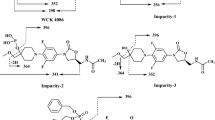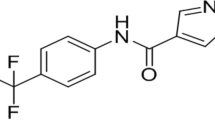Abstract
A commercial erythromycin formulation containing erythromycin A (EA) as the major compound showed the presence of an unknown degradation compound that was co-eluted with erythromycin E (EE) in the European Pharmacopoeia (Ph. Eur.) liquid chromatographic (LC) method. The amount of the degradation compound increased with respect to time. To separate this unknown (UNK1), investigation was performed with different LC methods coupled to ultraviolet detection (LC-UV). With the present Ph. Eur. method, the degradation compound could not be well separated. However, with the most selective LC-UV method (XTerra method), two more degradation products (UNK2 and UNK3) were found in the formulation which could not be observed using other methods because of their poor separation. By combining the results obtained with LC-UV, LC/MS and LC/NMR, the degradation products were identified as pseudoerythromycin A hemiketal (PsEAHK), erythromycin A enol ether carboxylic acid and erythromycin C enol ether carboxylic acid. PsEAHK is known to be a base-catalysed degradation product of EA, whereas the other two degradation products were newly identified.









Similar content being viewed by others
References
Pettinga CW, Stark WM, van Abeel FR (1954) J Am Chem Soc 76:569–571
Wiley PF, Gale R, Pettinga CW, Gerzon K (1957) J Am Chem Soc 79:6074–6077
Majer J, Martin JR, Egan RS, Corcoran JW (1977) J Am Chem Soc 99:1620–1622
Martin JR, Egan RS, Goldstein AW, Collum P (1975) Tetrahedron 31:19851988
Martin JR, De Vault RL, Sinclair AC, Stanaszek RS, Johnson P (1982) J Antibiot 35:426–430
Steigbiegel NH (2000) In: Mandell GL, Bennett JE, Dolin R (eds) Mandell, Douglas, and Bennett’s principles and practice of infectious diseases, 5th edn. Churchill Livingstone, New York
Bryskier AJ, Agouridas C, Gasc J-C (1993) Macrolides, chemistry, pharmacology and clinical uses. Arnette Blackwell, Paris
Flynn EH, Sigal MV, Wiley PF, Gerzon K (1954) J Am Chem Soc 76:3121–3131
Freiberg LA (1972) US Patent 3,725,385
Atkins PJ, Herbert TO, Jones NB (1986) Int J Pharm 30:199–207
Kibwage IO, Busson R, Janssen G, Hoogmartens J, Vanderhaeghe H, Bracke J (1987) J Org Chem 52:990–996
Kirst HA, Wind JA, Paschal JW (1987) J Org Chem 52:4359–4362
Cachet Th, Van den Mooter G, Hauchecorne R, Vinckier C, Hoogmartens J (1989) Int J Pharm 55:59–65
Vinckier C, Hauchecorne R, Cachet Th, Van den Mooter G, Hoogmartens J (1989) Int J Pharm 55:67–76
Paesen J, Khan K, Roets E, Hoogmartens J (1994) Int J Pharm 113:215–222
Kim JH, Heinze TM, Beger R, Pothuluri JV, Cerniglia CE (2004) Int J Pharm 271:63–76
Paesen J, Roets E, Hoogmartens J (1991) Chromatographia 32:162–166
European Directorate for the Quality of Medicines (2011) European Pharmacopoeia, 7th edn.. Council of Europe, Strasbourg, France 1/2008:0179
Harang V, Westerlund D (1999) Chromatographia 50:525–531
Chepkwony HK, Vanderriest I, Nguyo JM, Roets E, Hoogmartens J (2000) J Chromatogr A 870:227–235
Wardrop J, Ficker D, Franklin S, Gorski RJ (2000) J Pharm Sci 89:1097–1105
Chepkwony HK, Dehouck P, Roets E, Hoogmartens J (2001) Chromatographia 53:89–92
Deubel A, Holzgrabe U (2007) J Pharm Biomed Anal 43:493–498
Dehouck P, Roets E, Hoogmartens J (2003) Chromatographia 57:671–675
Govaerts C, Chepkwony HK, Van Schepdael A, Roets E, Hoogmartens J (2000) Rapid Commun Mass Spectrom 14:878–884
Chitneni SK, Govaerts C, Adams E, Van Schepdael A, Hoogmartens J (2004) J Chromatogr A 1056:111–120
Haghedooren E, Bhupathi Raju KKRVS, Dehouck P, Govaerts C, Van Schepdael A, Hoogmartens J, Adams E (2006) J Pharm Biomed Anal 41:165–175
Deubel A, Fandiño AS, Sörgel F, Holzgrabe U (2006) J Chromatogr A 1136:39–47
Pendela M, Van den Bossche L, Hoogmartens J, Van Schepdael A, Adams E (2008) J Chromatogr A 1180:108–121
Van den Bossche L, Lodi A, Schaar J, Shaakov S, Zorzan M, Tranquillini ME, Overballe-Petersen C, Hoogmartens J, Adams E (2010) J Pharm Biomed Anal 53:109–112
Acknowledgement
The NMR part of this work was supported by the National Scientific Research Fund of Hungary, OTKA K73804.
Author information
Authors and Affiliations
Corresponding author
Electronic supplementary material
Below is the link to the electronic supplementary material.
ESM 1
(PDF 347 kb)
Rights and permissions
About this article
Cite this article
Pendela, M., Béni, S., Haghedooren, E. et al. Combined use of liquid chromatography with mass spectrometry and nuclear magnetic resonance for the identification of degradation compounds in an erythromycin formulation. Anal Bioanal Chem 402, 781–790 (2012). https://doi.org/10.1007/s00216-011-5450-0
Received:
Revised:
Accepted:
Published:
Issue Date:
DOI: https://doi.org/10.1007/s00216-011-5450-0




